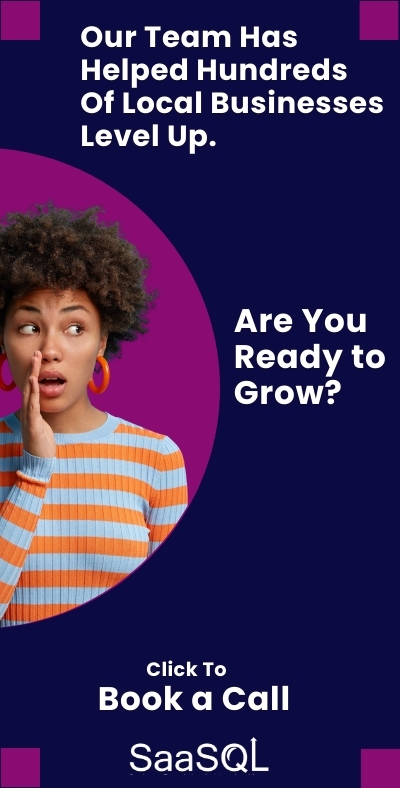AS MARKETING COSTS RISE WHILE ATTENTION SPANS AND CONVERSION RATES DECLINE, THESE 3 INNOVATIVE MARKETING TACTICS GIVE LOCAL BUSINESSES AN EDGE
In recent years we’ve seen the development of numerous innovative marketing tactics, each designed to capture the attention of fragmented, targeted consumers, building influence incrementally throughout the purchase cycle. While these methods, which are rooted in a deep understanding of consumer behavior and reflect a nuanced approach to outreach are impactful, many are cost-prohibitive for local businesses. With that in mind, the following is a list of the 3 most innovative marketing tactics for budget-conscious local businesses. As standalone techniques, they are largely low cost, high ROI solutions. They also act as a foundation for a local business growth strategy.
Becasue all effective marketing must put the consumer at its center, lets first cover some techniques that can provide powerful insights to fuel any new effort.

THE THREAD THAT LINKS ALL INNOVATIVE MARKETING TACTICS
Any transformative marketing effort has to begin with the ideal customer. As a result, developing a complete understanding of who is most likely to buy from your local business is the foundational stage in crafting next-generation marketing strategy. As simple a concept as this might seem, it is also often overlooked. So, who exactly is the ideal customer for your product or service? What do they do for a living? What motivates and inspires them? What do they most value? What is their family dynamic? What triggers them to make a change? For local, expense conscious businesses, the most efficient way to get to this information is to go directly to the source: your current buyers.
By Actively seeking feedback from customers through feedback forms, automated emails, or phone calls, it’s possible to uncover unknown truths about your customer base. Equally important, you’re in the position to secure both positive and negative feedback about customer experiences with your brand. Not only does this enable local businesses to craft an innovative marketing plan, it also promotes customer retention and repeat business.
Beyond the current customer base, the following are four (free) resources that can be enormously helpful in learning more about your ideal customer.
•Social Media Listening: While there are paid tools that can systemize this approach, the free version also works well. Simply go to Facebook and search for your product or service. For example, you might search “Install a Fence”. Then, on the left click “Posts” and be rewarded with a wealth of information directly individuals who are interested in this topic. What are they talking about? How do they make their decisions? What factors play a role? Which companies do they recommend? Much to learn, here. For a different audience perspective, visit Reddit and do the same.
•Answerthepublic.com: Recently acquired by NP Digital, this tool still enables users to conduct 3 free searches per day and is invaluable. Search for any topic and be rewarded with the specific questions consumers are asking about that product or service. It is a direct window into what is meaningful to consumers when they’re making purchasing decisions.
•Google Trends: Here you can see which topics that are related to your business are seeing a lift in demand. Topics, Search Queries, Geographies, news, related images, and videos: all easily segmented and sorted.
•Google Analytics: While this is the last on the list, it is certainly not least. In fact, this is the dataset that should be the standard in your customer analysis. As much as it is woefully under-utilized by local businesses, it is also brimming with data. With the launch of GA4, we now have access to even more ways to sort these various signals into useful and actionable insights. With the installation of a Meta pixel, similar useful information can be found in the Meta Business Suite.
By employing a combination of these methods, you can gain a holistic understanding of your target audience, enabling you to utilize the following tactics in a way that will deeply resonate with your customers and differentiate your brand.
THE 3 MOST INNOVATIVE MARKETING TACTICS FOR LOCAL BUSINESSES
MARKETING AUTOMATION: PERSONALIZED MARKETING, AT SCALE
Artificial intelligence and machine learning are enabling marketers to personalize their marketing at scale like never before. This includes everything from simple targeted ads to personalized product recommendations. An easy example most can relate to is Netflix, with its use of AI-recommended additional viewing. Amazon follows similar behavioral cues to recommend new products to its customers. This tactic even plays out at local grocery stores, as coupons, that coincidentally align with one’s purchase history, print alongside receipts at checkout.
This is well and good for the Fortune 500, but how do local businesses deploy similar strategies without massive marketing budgets?
The answer lies, once more, in the customer. The simple act of routinely collecting contact information for current customers provides the capability. The strategy lies in utilizing inexpensive marketing automation software (as little as $50 per month if you do it yourself, $300 if you have somebody do it for you), to use that information to maintain ongoing one-to-one connections, making personalized recommendations that increase the lifetime value of customers, while building a pipeline of inbound referrals.
If it sounds too good to be true, consider this: nearly 70% of local businesses don’t utilize their customer data, at all. This makes it fuel for the most under-utilized and innovative marketing tactics available. With the ability to integrate customer data into social media marketing, search engine marketing, email campaigns, video and audio platforms, direct mail and other addressable campaigns, the power of the customer database has the power to be truly transformative.
Some examples: An HVAC company sends a reminder, and an offer for annual Furnace and AC Servicing. A restaurant sends personalized offers for new specials that are likely to appeal to customers based on previous dining history. A non-profit creates look-alike audiences to find local consumers who are more likely to support their cause. A roofing company automates review requests, easily broadcasting positive reviews across online platforms, boosting inbound leads and decreasing the reliance on paid media.
By using technology to automate the process of collecting, analyzing, and using customer data, local SMBs create and deliver personalized marketing messages at scale in ways that increase customer engagement, loyalty, and sales.
DYNAMIC CROSS CHANNEL MARKETING: THE EVOLUTION OF OMNICHANNEL MARKETING AND A CHEAT CODE FOR LOCAL BUSINESSES
Since 2010, omnichannel marketing has been the secret weapon for corporations that wield elite marketing budgets. Representing the integration of marketing channels across all touchpoints, Ominichannel Marketing allows marketers to create a seamless and consistent customer experience through messaging that builds value. For example, an omnichannel marketing campaign might include ads on social media, email marketing, addressable commercials on streaming video platforms, and in-store promotions.
In each instance, containing messaging that interconnectedly guides consumers toward an inevitable purchase. The icing on the proverbial cake is the ability to deftly measure every consumer interaction to track which marketing channels build the greatest influence, over time. In addition to creating an atmosphere in which companies can “digitally surround” targeted consumers, completely owning their purchasing experience, this level of measurability also allows for a level of ongoing optimizations that steadily improves the ROI of marketing campaigns and decreases costs over time.
Dynamic Cross Channel Marketing takes things a step further, by linking every marketing component to a single budget, strategically migrating spend from one channel to the next, based on performance.
Rather than manually allocating a $2,000 monthly digital marketing budget between Google Ads, Social Ads and Display Ads (all executed through different ad-serving platforms), imagine having those marketing channels compete for their share of your budget by producing the highest quality conversions at the lowest possible cost. With Dynamic Cross Channel Marketing companies like Google and Facebook earn local marketing budgets through performance.
HYPERLOCAL SEO: LEVELING THE CORPORATE PLAYING FIELD
Second only to the underutilization of the Customer Database, local businesses consistently and woefully underutilize Local Search. The problem starts with the stain that has been cast upon the acronym “SEO”, which carries nearly 20 years of snake oil, bombastic promises, algorithm changes and swift let-downs. How, for example, can a local attorney compete with the likes of Find Law, Juvia, Avvo, Legal Match, Super Lawyers, LegalZoom, LegalShield, USA Attorneys, etc. With so much budget and know-how being directed at the SEO problem, how can local businesses possibly compete for organic website traffic?
Local Search is the answer. Between 45% and 70% of search engine queries end with a click on the “Maps Pack”. The section of the Search Engine Results Page that houses local listings, the Maps Pack is otherwise known as the categorical home for Google Business Profiles. It’s an algorithmic opportunity that could level the playing field between large corporations with massive budgets and local companies, with only a subtle shift of focus.
Google Business Profiles are a free tool that allows businesses to manage their online presence based on their physical location. Unlike the more commonly understood effort of optimizing a company’s website, the optimization of Google Business Profiles is more functional than technical: it’s all about engagement with the customer combined with a small dose of location verification.
Here are some innovative ways to optimize your Google Business Profile:
•Use Google Business Profile “Updates” to keep your profile fresh and engaging. Updates allow businesses to share news, updates, and offers with customers directly from their GBP profile. Posts can be texts or images and work best when they are relevant to the ideal customer, keyword rich and geographically specific.
•A high volume of high-quality photos and videos can be added by the business owner and customers/ What’s more, when they are routinely added (especially by customers), building volume over time, images and videos can have a powerful impact on rank and engagement.
•Developing an automated process to secure reviews form customers is critical. Reviews are one of the most important aspects of the Google Business Profile, helping potential customers learn more about businesses while playing a key role in Google’s ranking system. There are numerous tools available that systemize review requests in real, immediately after a transaction is completed.
•Respond to reviews promptly and professionally. Responding to reviews shows that you are engaged with your customers and that you value their feedback. It is also a good opportunity to address any negative reviews and resolve any issues that customers may have had.
•Syndicate local business information across other online directories. Syndication services can automate this processes very inexpensively, ensuring that your business’ name, address, phone numer and URL is listed accurately across the most well-known online directories. A key component to the Google Business Profile ranking system, directory syndication verifies the authenticity of your business.
INNOVATIVE MARKETING TACTICS: CONSUMER ENGAGEMENT THROUGHOUT THE BUYING CYCLE
If our digital history has taught us anything, it’s that marketing costs will continue to rise, consumer attention will become increasingly fragmented, and new changes and challenges will come. In a world inundated with information and choices, these tactics offer a roadmap for local businesses to not only survive but thrive, because they are rooted in customer experience. By embracing strategies that build consumer engagement throughout the entire decision-making process, local businesses put themselves in a position to navigate the evolving marketing landscape.







